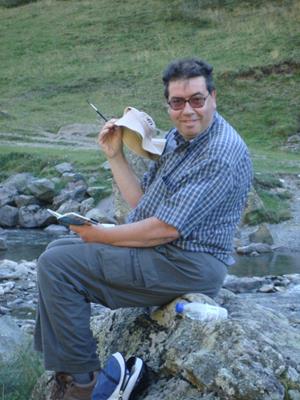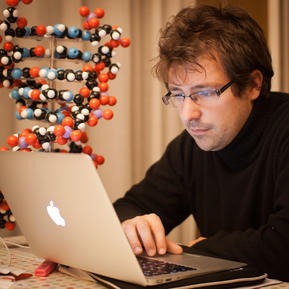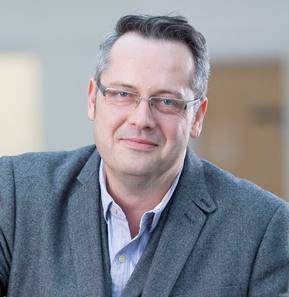|
Keynote 1
“Present and Future of Automatic Control” João Miranda Lemos INESC-ID/IST/Univ. Lisboa, Portugal |

|
Abstract: In one form or another, many times in unexpected ways, Automatic Control is at the core of the technologies that allowed the astonishing progress and well-being of the Human Race in the last century. It is not therefore surprising that the advances in this area result from a deep interplay between social needs, available implementation technologies, and basic sciences. This lecture examines these driving forces in order to try to individuate major avenues of research. In addition to basic needs such as energy, water, efficient transport of persons and goods and healthcare, modern societies are increasingly being confronted with new challenges, such as to ensure security and self-social regulation, sustainable development in a distributed and parity way, or to ensure a democratic and fare functioning. Although major advances in technologies such as Electronics, Sensing and Instrumentation, Communications, and Computer Science and Engineering provide the necessary means to disseminate low cost consumption equipment and services in un-precedent ways, they are not just by themselves sufficient to address those major challenges. However, they provide the means to implement global solutions offered by Systems Decision and Control. In this realm, Automatic control is not just a way to yield ad hoc solutions for regulating variables in machines and devices as it used to be up to the mid twentiest-century, but provides an integrating framework for design in which systems of different kinds (technical, biological, societal, computational, etc.) interact through networks, with the recently coined expression “cyber-physical systems” aiming to reflect this fact. The tools needed to address the above problems reflect their specific features. Distributed Model Predictive Control and Optimal Control exploiting the Cloud, design algorithms for controllers able to tackle high levels of uncertainty and reconfiguration for fault tolerance, and hybrid systems of various forms provide examples. All over, methods from distributed optimization and mathematical methods that allow tackle uncertainty and time variation are major landmarks. The cross-breeding between Automatic Control and Machine Learning is also a clearly recognizable trend. Most problems in the classes considered above, as in general engineering problems, are formulated as optimization problems. When Gauss, and later Wiener, formulated estimation problems as quadratic minimization problems, they opened a large avenue to modern systems and control engineering, where the Kalman-Bucy filter and the LQG controller are milestones. Despite its crucial importance, problem formulations based on different criteria, in particular those that lead to the so called “sparse solutions” are assuming an increased visibility for the quality of the performance they yield. In turn, these methods require mathematics that used to be seen as somewhat exotic, like non-smooth analysis and optimization, but that now start to be seen as essential tools.
Speaker Bio: J. M. Lemos is, since 2001, full professor (“Professor Catedrático”) of Systems, Decision and Control at the Department of Electrical and Computer Engineering of IST, University of Lisbon, Portugal and scientific coordinator of the research group on Control of Dynamic Systems at INESC-ID. He completed his Ph. D. in 1989, at IST, after extensive periods of work at the University of Florence, Italy.
For 6 years he was Chairman of the Scientific Council of INESC-ID. He was also Chairman of the Electrical Engineering Department at IST (comprising at the time over 140 professors and 40 administrative and technical staff members) from October 2004 until September 2006, Coordinator of the Post-Graduation Courses (M. Sc. and Ph. D.) in Electrical and Computer Engineering from January 2002 until September 2004, and served several terms as a member of the coordination team of the Master and Doctoral Programmes on Aerospace Engineering of IST to which he currently belongs.
Since completing the Ph. D., he has devoted his attention to problems in computer based systems and control, including adaptive control, multiple model based algorithms for control and estimation, and distributed optimal and predictive control. He was responsible for research projects on distributed control of water delivery canals; modelling of thermoelectric power units; adaptive and robust control of superheated steam temperature control in thermoelectric power units; adaptive control of distributed collector solar fields, solar furnaces and solar towers; adaptive control of arc welding; control applications to biomedical applications, including robust control of anaesthesia and therapy design based on optimal control for HIV infection and cancer. He supervised 15 Ph. D. thesis in his areas of specialization and published around 250 research papers in peer reviewed scientific journals, international symposia and book chapters. He authored the book “Adaptive Control of Solar Energy Collector Systems”, published by Springer in 2014.
He devotes his spare time to paint watercolours and urban sketching, research in local history, with 4 research papers published related to the city of Porto in the XIX century, fishing in rivers, hearing music and reading.
|
Keynote 2
“Micro-Data Learning for Animal-Like Adaptation in Robots” Jean-Baptiste Mouret French Institute for Research in Computer Science and Control (INRIA), Nancy, France |

|
Abstract: A large part of the impressive results achieved with modern machine learning (in particular, by deep learning) are made possible by the use of very large datasets. However, robots have to face the real world, in which trying something might take seconds, hours, or days. And seeing the consequence of this trial might take much more. In spite of these constraints, robots are expected to adapt like humans or animals, that is, in only a handful of trials: we refer to this challenge as "micro-data learning". In this talk, I will describe our ongoing efforts to design micro-data learning algorithms that allow robots to discover new behaviors by trial-and-error in a few minutes (a dozen of trials), and I will highlight how such algorithms allow robots to recover from unforeseen damage (e.g., a walking robot with a broken leg) without requiring a diagnosis or an explicit update of the internal model.
Speaker Bio: Jean-Baptiste Mouret is a "research director" (senior scientist) at Inria, the French research institute dedicated to computer science and mathematics. He was previously an assistant professor ("maître de conférences") at the Pierre and Marie Curie University (Paris, France). He is the principal investigator of an ERC grant (ResiBots – Robots with animal-like resilience, 2015-2020) and was the recipient of a French “ANR young researcher” grant (Creadapt – Creative adaptation by Evolution, 2012-2015).
Overall, J.-B. Mouret conducts researches that intertwine machine learning and evolutionary computation to make robots more adaptive. His work was recently featured on the cover of Nature ("Robots that adapt like animals", Cully et al., 2015) and it received the "Outstanding Paper of 2015" award from the Society for Artificial Life (2016), the French "La Recherche" award (2016), and several best paper awards in major conferences.

|
Abstract: Human to Human communication and interaction is something that we take for granted, yet it is essential to every collaborative task we undertake. Providing machines with the ability to watch, interpret and even predict humans pervades computer vision but as we have yet to develop generic AI, it is typically broken down into subtasks such as gesture recognition, activity recognition or behaviour prediction. This talk will look at ongoing efforts to develop tools for weakly supervised learning from humans. We will look at approaches to communication including lip reading, gesture recognition, expression and nonverbal communication. A challenging domain that includes many of these elements in parallel is Sign Language Recognition and the problem of end-to-end translation. We will also look at learning from humans using imitation and reinforcement learning and how machines can develop their own strategies to problem solving.
Speaker Bio: Richard Bowden received a BSc in computer science from the University of London in ’93, an MSc with distinction from the University of Leeds in ’95, and a PhD in computer vision from Brunel University in ’99 for which he was awarded the Sullivan Doctoral Thesis Prize. He is Professor of Computer Vision and Machine Learning at the University of Surrey, UK, where he leads the Cognitive Vision Group within the Centre for Vision Speech and Signal Processing and was recently awarded a Royal Society Leverhulme Trust Senior Research Fellowship. His research centres on the use of computer vision to locate, track, and understand humans. He is an Associate Editor for Image and Vision Computing and IEEE Pattern Analysis and Machine Intelligence. He was a member of the British Machine Vision Association (BMVA) executive committee and a company director for seven years. He is a member of the BMVA, a fellow of the Higher Education Academy, a senior member of the IEEE and a Fellow of the International Association of Pattern Recognition.

